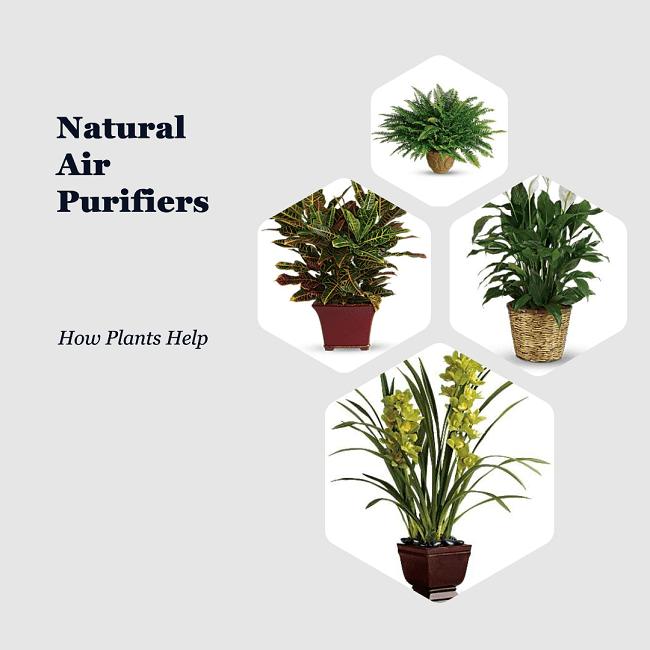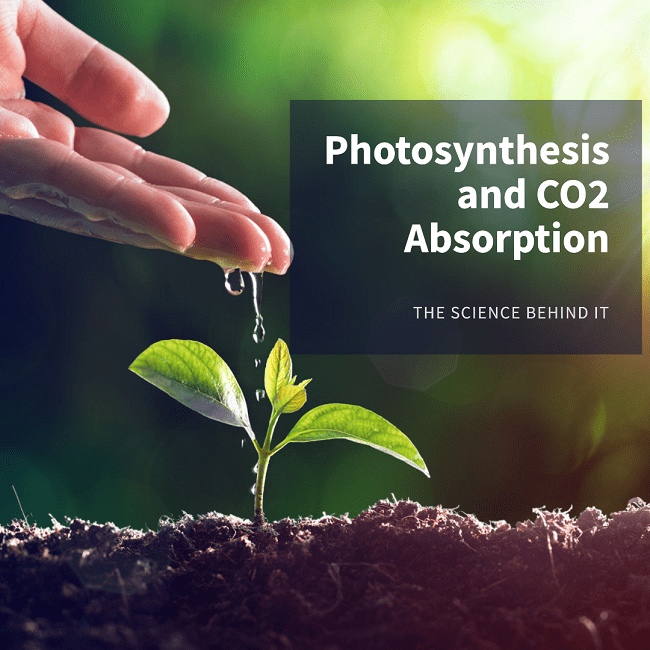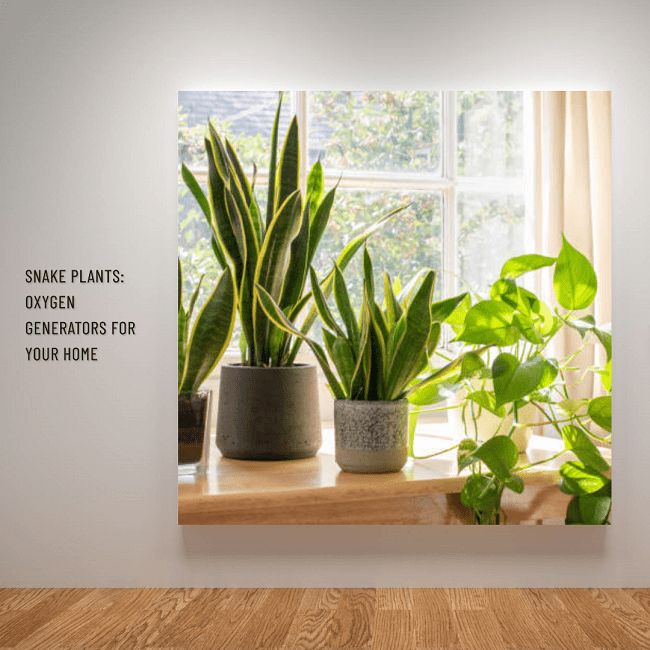Breathing Easy: The Ultimate Guide to CO2-Absorbing Plants for Cleaner Air at Home

Introduction
The Increasing Importance of CO2 Absorption
As our environmental worries keep growing, it's become more and more clear that soaking up carbon dioxide is a key piece of the puzzle in tackling climate change and making the air we breathe better. We're all aware that high levels of CO2 are heating up our planet, and it's become crucial to find practical, affordable, and efficient ways to bring those levels back down.
Interestingly, over time, plants have naturally developed to play a pivotal part in the Earth's carbon cycle.. Through photosynthesis, they absorb CO2 and sunlight to produce oxygen and glucose, effectively acting as natural carbon sinks. However, the potential for leveraging this natural CO2 absorption capacity within our homes and living spaces remains underexplored and undervalued.
How Plants Act as Natural Air Purifiers
The idea of plants serving as organic air purifiers has been around for a while, but it's more relevant now than ever, due to the rise in indoor air pollution. These living green filters can remove harmful toxins and improve air quality, making our homes healthier and safer. With their natural ability to purify air, plants are not just aesthetically pleasing but also essential for our well-being. This crucial role should make us consider integrating more plants into our indoor spaces. Indoor settings often harbour numerous pollutants, such as volatile organic compounds (VOCs) emitted from furniture, paints, and cleaning products, as well as an excess of CO2 produced by humans and pets. These pollutants can negatively affect our health and comfort. Luckily, nature provides us with an efficient solution – indoor plants. These green allies not only enhance our surroundings aesthetically, but they actively absorb harmful pollutants, providing a cleaner and healthier environment. Truly, plants are more than just decoration, they're silent guardians of our air quality.
Plant leaves, roots, and associated microorganisms can remove these harmful substances from the air, improving its overall quality. The process is simple but highly effective: as plants absorb CO2 and pollutants, they release oxygen through photosynthesis, contributing to cleaner, fresher, and healthier air.

Beyond their air-purifying abilities, plants also enhance the aesthetic appeal of indoor spaces, create a calming environment, and can even help reduce noise levels.
Given these numerous benefits, incorporating CO2-absorbing plants into our homes and workplaces seems like a breath of fresh air - both literally and metaphorically. As we venture further into this guide, we'll discover the best plants for this purpose, their care requirements, and how to maximize their air-purifying potential.
Understanding CO2 Absorption in Plants
The Science of Photosynthesis and CO2 Absorption
Photosynthesis is a fundamental biological process in which plants convert sunlight into chemical energy. In this process, plants absorb CO2 from their environment, along with water absorbed through their roots, to produce glucose and oxygen. The glucose is used as an energy source for growth and development, while oxygen is released back into the atmosphere.

The photosynthesis equation succinctly summarizes this process:
6CO2 + 6H2O + sunlight ⟶ C6H12O6 + 6O2
However, this simple equation belies the intricate, complex machinery at work within each plant cell. Believe it or not, photosynthesis is quite the intricate dance. It happens inside the chloroplasts of plant cells, with several steps taking turns in the spotlight, some needing light to strut their stuff, and others that can groove in the dark. Regardless, the end result remains the same: CO2 is absorbed, and oxygen is produced.
Effects of Excessive CO2 Levels on Indoor Air Quality
Indoor CO2 levels can be significantly higher than those outdoors, especially in poorly ventilated spaces. While we often associate air pollution with outdoor environments, research indicates that indoor air can be up to five times more polluted.
Too much CO2 in your surroundings isn't just bad for the planet, it's bad for your health too. From pesky headaches to dizziness, shortness of breath, and even clouding your thinking - it's like a rogue's gallery of unwanted houseguests. Over time, high CO2 levels can also increase the risk of respiratory diseases and allergies. Therefore, maintaining good indoor air quality is not just beneficial, but essential for our well-being.
Why Certain Plants Absorb More CO2 than Others
While all plants absorb CO2, some species are better at it than others. The rate of CO2 absorption depends on a range of factors, including the plant's size, age, health, and the species-specific metabolic rate.
Interestingly, some plants continue to absorb CO2 even in the absence of light, thanks to a photosynthetic adaptation called Crassulacean Acid Metabolism (CAM). CAM plants, such as succulents, store CO2 absorbed at night for use during the day, thereby purifying the air around the clock.
Moreover, certain plants are more efficient at removing other air pollutants, such as benzene, formaldehyde, and trichloroethylene, enhancing their overall air-purifying capabilities.
As we continue, we'll dive into a curated list of such plants that excel in CO2 absorption and provide cleaner, healthier air in our homes and workplaces.
In our modern world, finding practical and cost-effective ways to reduce CO2 levels is more important than ever before. Our homes are no exception. Here's where house plants come into the picture. Their natural ability to act as air purifiers makes them essential home companions.
This fact leads us to the question, why are certain plants more efficient at absorbing CO2 than others? Just as we humans have our unique traits, plants do too. The amount of CO2 a plant can absorb is tied to its photosynthesis process—the way a plant feeds itself. Photosynthesis is a bit like cooking. Each plant has its recipe, using sunlight, water, and CO2, resulting in oxygen and glucose. Some plants are just better chefs, able to whip up a feast while consuming more CO2. However, if you're looking for more detailed insights into plant care and selection, we have a comprehensive guide on 'Selecting and Caring for Indoor Plants'.
Let's shed some light on a few CO2-absorbing houseplants. The Boston Ferns, Snake Plants, Succulents, and Prayer Plants are well-known oxygen generators, and they each bring something unique to your home. Boston Ferns, for example, are ancient plants with modern applications, absorbing more CO2 than the average house plant. If you're into succulents, our post on '5 Reasons Why You Should Grow Succulents in Your Home' gives an intriguing look into these hardy little wonders.
Incorporating plants into your home decor not only improves air quality but also adds a splash of life and color to your space. A well-placed Boston Fern or a creatively arranged collection of succulents can transform a room. To infuse some floral trends into your space, explore our post on 'TikTok Is Reviving Flower Arrangement Art: A Deep Dive into the Hottest Floral Trends'.
By embracing these green, air-purifying marvels, we're stepping into a greener, more sustainable future. As the trends in the plant and floral industry continue to evolve, we are seeing a significant shift towards eco-conscious living. If you're curious about these trends, our article 'Top Flower Trends of 2023: Transform Your Floral Experiences' is a great read.
In summary, integrating CO2-absorbing plants into our homes and lives holds immense benefits, from purifying the air we breathe to bringing us closer to nature. If you want to delve deeper into the world of plants and flowers, our piece on 'Blossoms of Time: The Art and Science of Preserving Floral Memories' is a fascinating exploration of how flowers touch our lives.
Spotlight on CO2-Absorbing House Plants
Boston Ferns: Ancient Plants with Modern Applications
Boston Ferns are a testament to nature's resilience. Belonging to a family of plants over 300 million years old, they've evolved to become one of the most efficient CO2-absorbing and air-purifying houseplants available. Their lush, feathery fronds act as natural air humidifiers and are particularly adept at removing harmful toxins like formaldehyde from the air. Keep these plants in indirect light, provide consistent moisture, and you've got yourself an attractive and effective air purifier right at home.

Snake Plants: Oxygen Generators for Your Home
Also known as Mother-in-law's Tongue, Snake Plants are hardy, versatile, and require minimal care, making them perfect for the novice indoor gardener. But their most impressive quality is their unique ability to absorb CO2 and release oxygen at night. Most plants pause photosynthesis when the sun goes down, but Snake Plants, being CAM plants, continue the process, purifying the air 24/7. Positioned in a bedroom, they can enhance your sleep quality by improving the night-time air.

Succulents: Compact Greenery with Big CO2 Impact
Succulents, with their striking forms and hardiness, have taken the houseplant world by storm. What's more, they are also CO2 absorption powerhouses. These desert natives follow the CAM process, absorbing CO2 at night when temperatures are cooler and humidity is higher, providing round-the-clock air purification. Plus, succulents are easy to care for and come in a wide variety of shapes, sizes, and colors, adding both aesthetic and air quality value to your home.

Prayer Plants: Vibrant Foliage and Air-Cleansing Powers
Prayer plants, known for their beautifully patterned, colorful foliage and unique movement (their leaves fold upward at night, like hands in prayer), are more than just pretty to look at. These tropical natives are also efficient at filtering CO2 from the air.

They thrive in low-light conditions and high humidity, making them perfect for bathrooms or rooms with fewer windows. Just like their counterparts mentioned above, Prayer Plants contribute to better air quality in your home while bringing a pop of color and life to your living space.
Benefits and Challenges of CO2-Absorbing House Plants
Benefits of Growing CO2-Absorbing Plants at Home
The benefits of cultivating CO2-absorbing plants at home extend far beyond aesthetics. Here are some of the major advantages:
Improved Air Quality:
By absorbing CO2 and releasing oxygen, these plants actively contribute to better indoor air quality. They can help mitigate some of the negative effects of pollutants like formaldehyde, benzene, and xylene.
Enhanced Mood and Focus:
Multiple studies suggest that being around plants can improve concentration, boost mood, and reduce stress levels. They bring a bit of nature into our indoor spaces, which can promote overall well-being.
Contribute to Fighting Climate Change:
By absorbing CO2, a greenhouse gas, these plants play a small role in combating climate change. While it might seem minuscule on an individual scale, if more people adopted houseplants, the collective effect could be significant.
Potential Challenges and Solutions in Indoor Plant Care
While the benefits are substantial, it's also essential to acknowledge that caring for houseplants can come with challenges. Here are some common issues and solutions:
Inadequate Light:
Lack of natural light can be a hindrance for indoor plants. However, many CO2-absorbing plants, such as Snake Plants and Prayer Plants, can tolerate low light conditions. If you have no natural light at all, consider investing in grow lights to provide your plants with the necessary light spectrum for photosynthesis.
Over or Under Watering:
Finding the right balance for watering can be tricky. The best approach is to understand the specific needs of your plants. For instance, succulents require less frequent watering than Boston Ferns. Always check the soil's moisture level before watering to avoid root rot.
Pest Infestations:
Indoor plants can sometimes attract pests. Regularly inspect your plants, isolate any that show signs of infestation, and treat with an appropriate pesticide or homemade solution.
The joy and benefits that CO2-absorbing plants bring to our lives far outweigh these challenges. With a sprinkle of patience and a dash of effort, you can transform your home into a lush indoor sanctuary. It's not just about making your space look good, but also about breathing life (literally!) into your living quarters.
Maximizing CO2 Absorption
Best Practices for Care and Maintenance of Boston Ferns
Boston Ferns require particular conditions to thrive. Here are some pointers:
Light:
They prefer indirect light. Place them near a north-facing window or somewhere out of direct sunlight.
Watering:
Boston Ferns enjoy damp soil. Try to keep the soil consistently moist but not waterlogged. Using a spray bottle to mist the leaves can also help maintain humidity.
Temperature:
These ferns prefer cooler temperatures, ideally between 60-75°F.
Cultivating Healthy Snake Plants for Optimal CO2 Absorption
Snake plants, also known as mother-in-law's tongue, are among the easiest plants to grow. Here are some tips:
Light:
Snake plants can tolerate a range of light conditions, but they prefer indirect sunlight.
Watering:
They are succulent-like in their water needs, which means you should let the soil dry out completely between watering.
Temperature:
Snake plants can handle a wide temperature range but do best between 70-90°F.
Growing Succulents: A Balancing Act between Sun and Water
Caring for succulents requires a bit of a balancing act:
Light:
Most succulents prefer bright light, and some even need direct sunlight. However, some species may scorch in the harsh afternoon sun.
Watering:
Succulents are desert plants and are adapted to dry conditions. Water them only when the soil has completely dried out.
Temperature:
They can handle a wide temperature range, but prefer it on the warmer side, ideally between 60-80°F.
Ensuring Your Prayer Plants Thrive: Tips and Tricks
Prayer plants are fascinating because their leaves fold up at night, as if in prayer. Here's how to care for them:
Light:
They prefer low to medium light and should be kept out of direct sunlight, which can scorch their leaves.
Watering:
Prayer plants prefer consistently moist soil. Avoid letting the soil dry out completely, but also ensure it's not waterlogged.
Temperature:
They enjoy warmer temperatures, ideally between 65-80°F.
Remember, the key to maximizing CO2 absorption by these plants is proper care. Healthy plants are better at photosynthesis and, thus, more effective at cleaning the air. Happy planting!
Other Noteworthy CO2-Absorbing Plants
Exploring Beyond the Popular Four: Other CO2-Absorbing Plant Options
While Boston ferns, snake plants, succulents, and prayer plants are popular for their air-purifying qualities, there is a broad spectrum of CO2-absorbing plants to explore for your indoor spaces.
Areca Palms are an excellent choice for larger spaces as they can grow up to 7 feet tall, providing ample greenery and high CO2 absorption.
If you're looking for flowering plants, Gerbera Daisies are a great option. Not only do they add a pop of color to your indoor space, but they are also highly effective at reducing indoor CO2 levels.
In addition, the Spider Plant is a hardy plant known for its ability to survive in less-than-ideal conditions, making it an excellent choice for beginners. Despite their simplicity, they are powerful air purifiers.
Lastly, Peace Lilies are an easy-to-maintain, shade-loving plant that not only absorbs CO2 but also eliminates harmful toxins like benzene and formaldehyde from the air.
Factors to Consider When Selecting Additional Plants
When selecting plants for your home, several factors should be considered. Your local climate, the plant's light and water needs, the space available, and whether you have pets or children who might interact with the plants are all important considerations.
Moreover, you should also assess the ease of care for the plant. While all plants require some care, some are much more demanding than others. If you're a novice plant owner, starting with hardy plants that require minimal care could be the best approach.
Remember, creating a greener indoor environment is not only about aesthetics but also about improving your indoor air quality. By considering these factors, you'll be able to find the perfect CO2-absorbing plants to fit your lifestyle and home.
Green Interiors: Incorporating Plants into Home Decor
Aesthetically Pleasing Plant Arrangements for CO2 Absorption
Interior design with plants can be a delightful exercise in creativity, bringing a breath of life into your living spaces. They can fit seamlessly into almost any decor style, from minimalist to bohemian. But their beauty is not only skin deep: these natural purifiers also contribute to a healthier indoor environment by absorbing CO2.
Arranging your plants in groups not only creates visual interest but also increases their effectiveness at purifying the air. Plants release moisture into the air, and grouping them can increase local humidity, assisting with photosynthesis, the process through which plants absorb CO2.
You can also think vertically: shelving, hanging baskets, and wall mounts can be used to display your green friends. This allows you to add greenery in small spaces or rooms without much floor space. Plants with trailing vines, like the English Ivy, make excellent hanging plants and are also adept at absorbing CO2.
The Art of Mixing and Matching Plants for Air Purification
When it comes to mixing and matching plants, there is an art to it. Different plants have different light, water, and care needs, so it's important to pair plants with similar requirements together. For instance, succulents and snake plants both thrive in drier conditions and can be grouped together.

Combining plants of varying heights, colors, and textures can create an attractive and dynamic display. Imagine the sleek, vertical lines of a snake plant paired with the dense, feathery fronds of a Boston fern, or the thick, fleshy leaves of a succulent against the delicate, lace-like leaves of a maidenhair fern.
Finally, remember that the containers your plants are in can also contribute to your decor. Ceramic pots, metal cans, glass terrariums, wooden crates, or even woven baskets can all serve as planters, each adding a unique touch to your interior design.
With a little creativity and consideration, you can curate a beautiful, air-purifying plant collection that reflects your personal style and improves your home's air quality.
Sustainability and Future Trends in CO2 Absorption
The Rise of Plant-Based Solutions in the Fight Against Climate Change
The escalating global climate crisis has spurred interest in a variety of solutions to mitigate the growing levels of carbon dioxide in our atmosphere. Among these, the role of plants as carbon sinks is gaining considerable recognition. By photosynthesizing, plants take in carbon dioxide and give out oxygen, thereby playing a critical role in combating air pollution and climate change.
Adopting CO2-absorbing plants is a small but significant step towards greater sustainability at an individual level. Integrating plants into our homes and workspaces not only helps create a healthier indoor environment, but it also contributes, on a larger scale, to the process of carbon sequestration.
This plant-based approach extends beyond residential spaces. Green infrastructure, such as green roofs and walls, urban gardens, and even whole buildings designed to accommodate plant life, is increasingly being incorporated into urban planning as an effective method for reducing CO2 levels and improving air quality in cities.
Future Trends in CO2 Absorption: What to Watch Out For
The interest in plants and their role in CO2 absorption isn't just a passing trend—it's a burgeoning field of research and innovation. Scientists are exploring new ways to maximize the carbon sequestration potential of plants, from genetic engineering to cultivation practices.
One area of particular interest is the development of "super plants" that can absorb more carbon dioxide than typical plant species. While this is still a burgeoning field of research, the potential implications for CO2 reduction are promising.
Another trend to watch is the development of advanced carbon capture technology inspired by natural photosynthesis. Known as artificial photosynthesis, this technology aims to mimic the way plants absorb and convert CO2 into oxygen and glucose.
On a more personal scale, we may also see an increase in indoor gardening systems designed to optimize CO2 absorption in the home. These could include smart planters with integrated monitoring systems for light, temperature, and humidity, designed to help plants thrive and maximize their CO2-absorbing capabilities.
As we collectively wrestle with the immense global task of climate change, it's becoming more apparent that our leafy green allies and their remarkable natural abilities will be critical players in sketching a sustainable future. By integrating more CO2-absorbing plants into our homes and lives, we can contribute to this global effort and reap the benefits of cleaner air and healthier living spaces.
Summary
Recap of CO2-Absorbing Plants and Their Benefits
Over the course of this guide, we've journeyed through the green and vibrant world of CO2-absorbing plants. We’ve seen how these plants, through the process of photosynthesis, can act as our personal indoor air purifiers, reducing carbon dioxide levels and improving overall air quality.
We dove into the science behind the CO2 absorption in plants and discussed how excessive CO2 levels can affect indoor air quality. We took a close look at four key indoor plants: Boston Ferns, Snake Plants, Succulents, and Prayer Plants, each with unique characteristics that make them particularly effective at CO2 absorption.
We also discussed the advantages and challenges of growing these plants at home, and shared tips to help you nurture them and maximize their CO2-absorbing potential. As we broadened our view, we explored other CO2-absorbing plant options and discussed factors to consider when selecting additional plants.
Beyond simply growing these plants, we looked at how they can be incorporated into home decor in aesthetically pleasing ways that also enhance their CO2 absorption.
Looking Forward: The Future of Indoor Air Quality and Plants
As we look towards the future, it’s clear that our understanding and application of CO2-absorbing plants will continue to evolve. The intersection of technology and nature is set to play an ever more critical role in our fight against climate change and air pollution. The advent of super plants, artificial photosynthesis, and smart indoor gardening systems is just the beginning.
Embracing the green thumbs in us doesn't just freshen up our living spaces, but it's also a small, yet significant step towards a greener, more sustainable future. It's about being kind to Mother Earth, one plant at a time. We're seeing a real heartwarming trend of people embracing nature, acknowledging its power to heal and safeguard our world. It's less of a trend, more a lifestyle change, as we all commit to nurturing our planet back to health.
In the end, fostering CO2-absorbing plants in our homes is not just about cultivating greenery. It's about participating in a larger movement towards sustainability, nurturing a deeper connection with nature, and making a positive impact on our world, one plant at a time.
Common Questions on Care and Maintenance of CO2-Absorbing Plants
-
How often should I water my CO2-absorbing plants?
Watering frequency depends on the type of plant. Snake Plants and Succulents prefer to dry out between watering, while Boston Ferns and Prayer Plants prefer consistent moisture. Always check the soil before watering and remember that overwatering is a common mistake in plant care.
-
How much sunlight do my plants need?
Again, this varies by plant. Snake Plants and Succulents enjoy lots of light, while Boston Ferns and Prayer Plants thrive in indirect light. If possible, research the specific light needs of each plant and try to mimic its natural habitat.
-
Do I need to fertilize my plants?
Fertilization helps provide plants with necessary nutrients. However, not all plants need to be fertilized frequently. During growing seasons, typically spring and summer, most plants appreciate a boost of nutrients. Use a balanced, water-soluble fertilizer and follow the instructions carefully to avoid over-fertilization.
Understanding the Impact of Indoor Plants on Overall Air Quality
-
Can indoor plants significantly improve air quality?
While plants do improve indoor air quality by absorbing CO2 and releasing oxygen, they're not a standalone solution for air purification. It's important to also maintain proper ventilation, control humidity, and reduce sources of air pollution in your home.
-
Do all plants absorb CO2?
All plants absorb CO2 during photosynthesis. However, not all plants do so at the same rate, and certain species are more efficient at CO2 absorption than others.
-
Can plants help reduce other pollutants besides CO2?
Yes, plants can also help reduce levels of certain pollutants like benzene, formaldehyde, and trichloroethylene. However, the extent of this absorption varies between plant species and pollutant type. For a comprehensive approach to reducing indoor air pollutants, consider a combination of plants, air purifiers, and regular cleaning.
